This is an ancient Chinese game. If we divide the square by seven geometric shapes, as shown in the figure, then from them you can make a huge number (several hundred) of a wide variety of silhouettes: a person, household items, toys, various kinds transport, numbers, letters.
The game is very easy to make. A square (its size can practically be any: 5 × 5, 7 × 7, 10 × 10, 12 × 12 cm, etc.) made of cardboard or plastic, equally painted on both sides, is cut into 7 parts. The result is 2 large, 1 medium and 2 small triangles, a square equal in size to two small triangles, and a parallelogram equal in area to a square.
Rules of the game:
1. Each assembled figure must include all seven elements.
2. When drawing up figures, the elements should not overlap each other.
3. The elements of the figures must adjoin one another.
When drawing up silhouettes, an adult constantly reminds children that it is necessary to use all parts of the set, tightly attaching them to each other.
An adult can use some techniques that will help the preschooler achieve the best results: offer an analysis of the sample as a whole or its most complex part, indicate the location of one or two figures in the silhouette being made, start laying out, and then invite the child to finish the silhouette or, conversely, complete that that was started by a child. It is necessary to constantly confirm the correctness of the child’s thoughts and actions, encourage him to plan the course of his work, discuss ways of laying out and results, encourage the desire to complete the work that has been started, overcoming difficulties in achieving the goal, fulfilling the plan.
Assistance to the child should be tactful, encouraging independence, activity, perseverance, initiative actions leading to the achievement of results. Direct instructions on what to do and how to do it should be avoided. Such advice to children is appropriate: “Look (look) at the picture carefully. What figures is it made up of?”, “Try to do it again, but in a different way”, “Remember how you laid it out last time, and start the same way”, “Think well first, and then do it.”
The game "Tangram" arouses great interest in children, contributes to the development of analytical-synthetic and planning activities, opens up new opportunities for improving sensory, developing creative, productive thinking, as well as moral and volitional qualities of a person.
The history of this game is interesting. Almost two and a half thousand years ago, the long-awaited son and heir was born to the elderly emperor of China. Years passed. The boy grew up healthy and quick-witted beyond his years. It gave the boy great pleasure to play with toys all day long. And then the emperor called to himself three wise men, one of whom was known as a mathematician, the other became famous as an artist, and the third was a famous philosopher. And he ordered them to come up with a game, amused by which, his son would comprehend the beginnings of mathematics, learned to look at the world with the watchful eyes of an artist, would become patient like a true philosopher, and also understand that often complex things are made up of simple things. Three wise men came up with "Shi-Chao-Chu" - a square cut into seven parts.
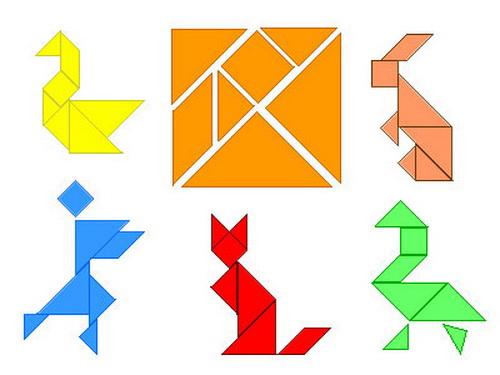
Stages of mastering the game "Tangram"
First step - familiarization with a set of figures for the game, converting them in order to compile a new one from 2-3 available ones.
I.
Target. Exercise children in comparing triangles in size, composing new geometric shapes from them: squares, quadrangles, triangles.
Material: children have sets of figures for the game "Tangram", the teacher has a flannelograph and a set of figures for him.
Working process. The teacher invites the children to consider a set of figures, name them, count and determine the total number. Gives tasks:
1. Select all triangles, count. Compare in size, superimposing one on top of the other.
Questions for analysis: “How many large triangles of the same size? How many little ones? Compare this triangle (medium size) with the big one and the small one. (It is larger than the smallest and smaller than the largest available.) How many triangles are there and how big are they? (Two large, 2 small and 1 medium.)
2. Take 2 large triangles and make them sequentially: square, triangle, quadrilateral. One of the children makes figures on the flannelgraph. The teacher asks to name the newly received figure and say what figures it is made of.
3. From 2 small triangles, make the same figures, placing them differently in space.
4. Make a quadrilateral from large and medium-sized triangles.
Questions for analysis: “What figure will we make? How? (Let's attach a medium triangle to a large one or vice versa.) Show the sides and corners of the quadrangle, each individual figure.
As a result, the teacher generalizes: “Triangles can be used to make new various shapes - squares, quadrangles, triangles. The figures join one another on the sides. (Shows on flannelgraph)
II.
Target. Exercise children in the ability to compose new geometric shapes from existing ones according to the model and design.
Material: for children - sets of figures for the game "Tangram". The teacher has a flannelograph and tables with geometric figures depicted on them.
Working process. Children, having examined the figures, divide them on the instructions of the teacher into 2 groups: triangles and quadrangles.
The teacher explains that this is a set of figures for the game, it is called a puzzle or tangram; so she was named after the scientist; who invented the game. You can compose many interesting images.
1. Make a quadrilateral from large and medium triangles.
2. Make a new figure from a square and 2 small triangles. (First a square, then a quadrilateral.).
3. Compose a new figure from 2 large and medium triangles. (Pentagon and quadrilateral.)
4. The teacher shows the tables and asks the children to make the same figures (see fig.). Children sequentially make figures, tell how they did it, name them.
The teacher composes them on a flannelograph.

The task is given to draw up several figures according to the children's own plan.
So, at the first stage of mastering the Tangram game, a series of exercises are carried out aimed at developing children's spatial representations, elements of geometric imagination, at developing practical skills in composing new figures by attaching one of them to another, the ratio of the sides of the figures by size. Tasks are changing. Children make up new figures according to the model, oral task, plan. They are offered to complete the task in terms of representation, and then practically: “What figure can be made up of 2 triangles and 1 square? Say first, then compose.
Second phase - drawing up silhouette figures according to dissected samples. The second stage of work with children is the most important for them to master more complex ways of drawing figures in the future. Games should be effectively used by the educator not only for the purpose of exercising in the arrangement of the parts of the figure being composed, but also in introducing children to the visual and mental analysis of the sample.
Drawing a silhouette figure of a hare
Target. To teach children to analyze the way the parts are arranged, to compose, a silhouette figure, focusing on a sample.
Material: for children - a set of figures for the game "Tangram", a sample.
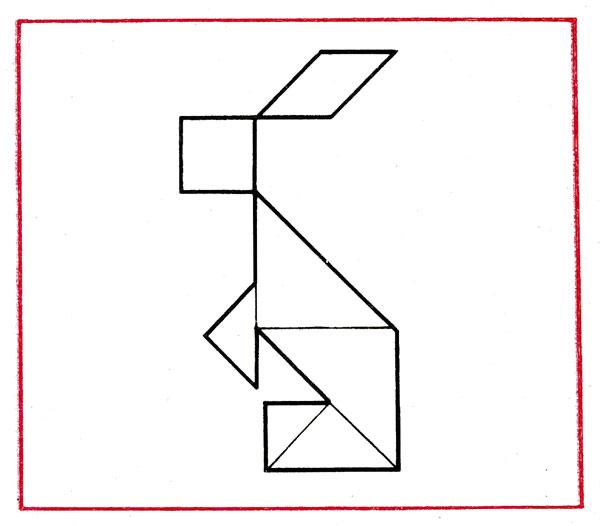
Working process. The teacher shows the children a sample of the hare's silhouette figure (see the figure) and says: “Look carefully at the hare and tell how it is composed. What geometric shapes are made up of the torso, head, legs of a hare? It is necessary to name the figure and its size, since the triangles that make up the hare (shows) are of different sizes; invites several children to answer.
R. The head of the hare is made up of a square, the ear is made of a quadrilateral, the body is made of two triangles, and the paws are also made of triangles.
IN. Was Kolya correct? If you spot errors, correct them.
The teacher asks another child to tell.
R. The body must be made up of 2 large triangles, the paw (this one) - from the middle triangle and the small one, and the other - from the small triangle.
IN. Now look at what geometric figure 2 large triangles form. Show the sides and angles of this figure.
R. This is a quadrilateral (shows its outline, counts angles, sides).
IN. And what shape does the middle and small triangle form together?
R. This is a quadrilateral, here (shows) not like a rectangle.
IN. So we looked at how the hare is made up, from what figures the body, head, and paws are made up. Now take your kits and compose. Who will complete the task, check whether it is correct.
After the figure is composed, the teacher asks two children to tell how they made the figure, that is, to name the location of the components in order.
R. I made it this way: the head and ear - from a square and a quadrangle, the body - from 2 large triangles, paws - from a medium and small one, and 1 paw - from a small triangle.
R. My ear is made up of a quadrangle, my head is made of a square, my paw is made of a triangle, my torso is made of large triangles, my paws - these are - from 2 triangles.
Sample analysis in this case conducted under the guidance of a teacher. In the future, children should be invited to independently analyze the figure and draw it up.
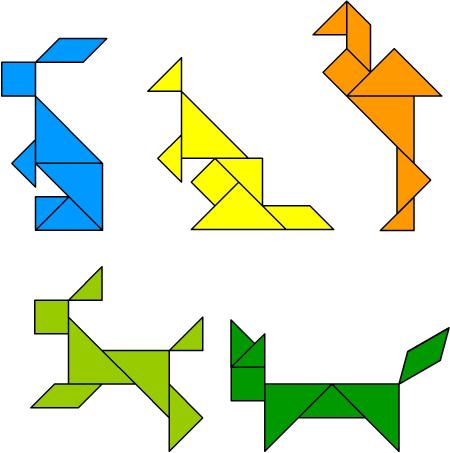
Third stage mastering the game - recreating figures according to contour patterns (undivided)
Recreation of the figure-silhouette of a running goose
Target. To teach children to presumably tell the way the parts are arranged in the figure being composed, to plan the course of compilation.
Material: sets, figures for the game "Tangram", flannelgraph, sample, board and chalk.
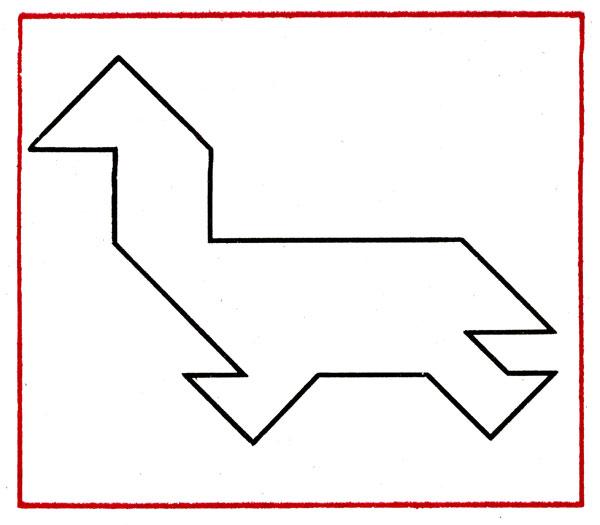
Working process. The teacher draws the attention of the children to the sample: “Look carefully at this sample. The figure of a running goose can be made up of 7 parts of the game. We must first tell you how this can be done. What geometric shapes can be used to make the body, head, neck, legs of a goose?
R. I think that the body is made up of 2 large triangles, the head is made of a small triangle, the neck is made of a square, the paws are triangles.
R. I think that the head is made up from the middle triangle, and then everything is the same as Lena said.
R. The head is from a middle triangle, the neck is from a square, and the body is from 2 large triangles, like this they lie (shows), and a quadrangle, and the legs are from small triangles.
IN. Take the figures and compose. And we will find out which of the guys is right.
After most of the children make up the silhouette of a goose, the teacher calls one child who draws the location of the parts with chalk on the board. All children check the figures they have compiled with the image on the board.
In the future, it is possible to analyze the sample of the figure being compiled not at the beginning of the lesson, but during it, when the children test various ways of drawing up based on the presumed self analysis.
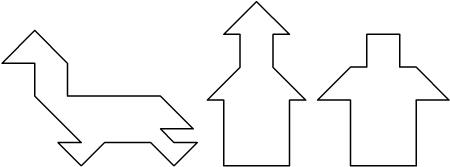
This is one of the most fascinating and educational children's creativity, which results in original and unique crafts made by the hands of kids.
In general, children begin to get acquainted with such simple and accessible material as paper junior group kindergarten, trying to create the most simple works from it with the help of teachers. Basically, during this period, the technique of cutting off individual elements of the future picture is used, or they are prepared (cut out) by educators in advance. Later, at an older age of the garden and elementary school When children master scissors, they cut out all the necessary components themselves, performing work in a variety of techniques.
As we noted above, one of interesting views such creativity is undoubtedly application of geometric shapes. I must say that this direction is most liked by the guys, because thanks to him they learn the name of the figures, learn to distinguish them and make the most unusual paintings and compositions, showing all his unbridled imagination. In addition, in the process of such work, children perfectly develop memory, perseverance, patience, accuracy, and involved fine motor skills fingers is excellent for mental abilities.
What exactly can be obtained on the basis of the usual set of circles, squares, rectangles, triangles, ovals and rhombuses. Let's figure it out together with the master classes offered to you below.
Application from geometric shapes: templates
Applications from geometric shapes for children
House in the village. Work for children preschool age.
The first version of the work is designed for the smallest children, or rather, it is the joint work of parents and their children, or a similar one is performed. Moms, dads or educators should prepare in advance all the necessary components of the composition, and the kids should assemble a ready-made picture from them, following the example.
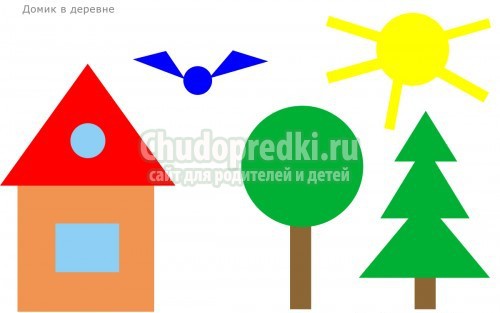
So, for work in this case, you will need the following materials and tools:
Colored paper in green, red, yellow, brown, blue, cyan and light brown;
A sheet of cardboard, A4 format;
Scissors;
Ruler;
Simple pencil;
Compass;
PVA glue or glue stick.
Description of work.
1. First you need to prepare all the components of the future painting-application. To do this, take a sheet of red paper and draw a large isosceles triangle on the back side, with sides, approximately 3.5-4 cm. This will be the roof of our house.
2. Next, take measurements of the lower side of the triangle and, starting from this indicator, on a light brown sheet, draw a square with the appropriate dimensions on the back side with a ruler and a pencil. This will be the main part of the house.
3. On a green sheet, using a ruler, we will sketch three isosceles triangles of different sizes, and each subsequent one should not be much smaller than the previous one, later the child will make a Christmas tree from these parts. In addition, using a compass or any other round object of suitable size, for example, a glass or a cup, we draw one circle with a diameter of about 2-2.5 cm. In the picture, it will turn into a tree crown.
4. Now we need Brown color, on such a sheet we will draw two identical narrow rectangles, rather resembling stripes, each 5-7 ml wide. We will need such details to create a tree trunk and a Christmas tree.
5. Draw a small rectangle on blue paper, 1.5 cm wide and 2 cm long, as well as a small circle, no more than 1 cm in diameter. Both details will serve as windows in our application picture.
6. Yellow color we will, of course, have a sun, to complete it we need to draw a circle with a diameter of 2 cm and 5-6 thin stripes of the same length and width for the rays.
7. Based on the last sheet of blue color, a bird soaring in the sky will be made. To create it, we will draw a small circle, no more than 1.5 cm in diameter, as well as two completely identical rectangular triangles.
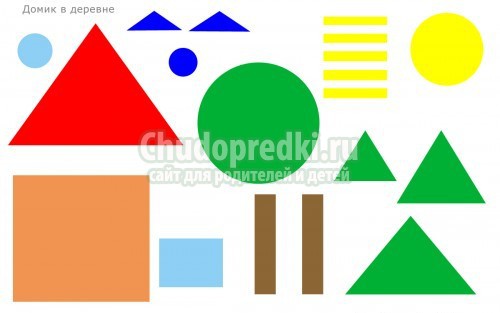
8. After all the details are ready, carefully cut them out with scissors along the contour, and lay them out on the table in groups, as they will be combined with each other on the craft. For example, in a separate pile we will collect a large red triangle, a light brown square, a blue rectangle and a blue circle - all these parts are the components of the house, and in another pile we will define three different green triangles and one brown strip - these details will turn into herringbone.
9. Now you can start the creative process, entrust this important task to your child. Start with the largest and central object of the composition - the house. Pay attention to the baby that he must stand on the ground, and not fly in the air, so the bottom of the object should be glued as low as possible to the base of the cardboard sheet, located horizontally.
10. Following the first object, you can begin to form the next ones - a tree and a Christmas tree.
11. Then move to the top of the cardboard base and make the sun and the bird there.
Pay attention to the proper application of adhesive to the parts. It should be applied from the back side, with a special brush, and coat the entire surface, and not just the middle or edges. In addition, it is important to calculate the amount of glue, it should not be too much, otherwise the paper parts will be heavily saturated with it, wrinkle and deform, completely spoiling the attractive appearance of the application picture. Unlike PVA glue, it is much easier to work with glue stick, besides, it does not spill on tables, does not spoil clothes and does not remain on fingers, therefore, many experts recommend this particular form for children's creativity.
12. We leave the finished picture to dry a little, after which you can decorate the wall in the children's room with it, or present it as a gift for the birthday of grandparents, etc.
Cheerful crab. Application from figures 1 class
This picture-application is suitable for children of the first grades. Usually, at this age, children already know what a circle, square, triangle, etc. is, so the creative process is designed more for the development of imagination than for learning the basics of geometry. In this case, it is proposed to compose a composition not based on a set different types geometric figures, but only on the basis of one - a circle, proposed in different sizes.

For work you will need:
Cardboard base in blue;
Colored paper in coral or red, as well as white, black, pale blue;
Scissors;
PVA glue;
Compasses or round stencils.
Application of geometric shapes Grade 1- description of work
1. Initially, we have to make a lot of circles of different sizes. Before we do this, we will depict all the necessary elements on colored sheets. In total, we need to draw on coral paper: 2 circles with a diameter of 5 cm, 10 circles with a diameter of 2.5 cm, and 2 circles with a diameter of 1.5 cm. On white paper: 2 circles with a diameter of 7 ml and on black: 2 circles with a diameter of 2 ml. You can draw circles using a compass or using suitable objects for this - glasses, jars, cups, etc. You can also take cardboard templates made in advance as a basis. They can be easily drawn in graphic computer program, print on a printer and use at work.
3. Now you can proceed directly to the creation of the composition. We start with the main body of the crab. It consists with us on the basis of the two largest circles. We fold each of them exactly in half, and so that they do not open, we fasten each with a small amount of glue.
4. After that, we glue our halves in the center of the blue cardboard base, so that we get a slightly open mouth of the crab (see photo).
5. Then we will form the claws. To do this, we need 4 medium-sized mugs and 2 small mugs, all coral. We fold the medium circles as well as the large ones in half to make semi-circles and fix each with glue.
6. Glue from the beginning symmetrically in the upper part of the crab's body two small circles, and then supplement them with semicircles, so that we get claws.
7. For the manufacture of paws, we take the remaining coral circles, there should be 6 of them, and, according to the familiar principle, we fold each in half and glue it.
8. Glue the paws three pieces one by one on the underside of the crab's body, first on the right and then on the left.
9. It remains only to complete the eyes, we use white and black circles for this, while the white ones will be the main part of the eye, and the black ones will be its pupils.
This offer to you application of geometric shapes - compendium to create which, you can take into service, is far from the only thing that can be made up of one type of form. Below we bring to your attention a small selection of no less interesting ideas for compiling picture applications exclusively from circles, circles and circles.
Animals from geometric shapes - applique

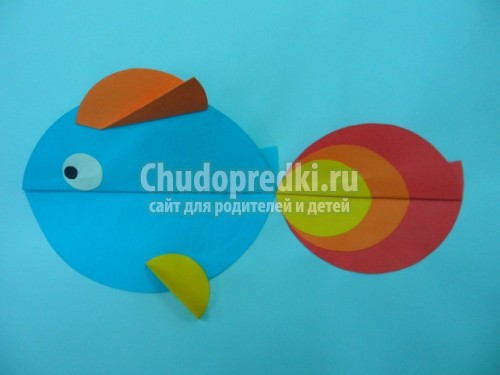


We also bring to your attention excellent templates that help you create original works on any topic.
Application of geometric shapes Grade 1 - templates.
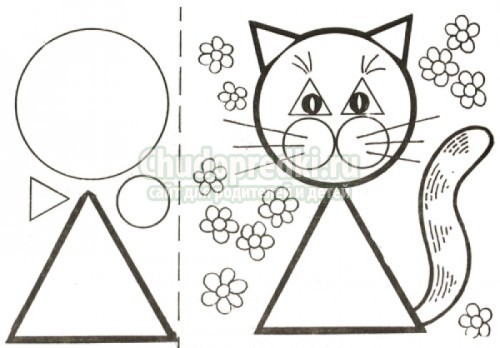

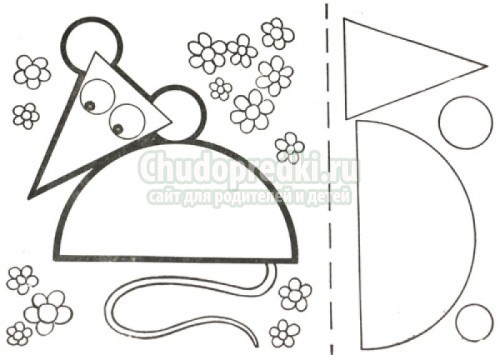
Felt butterfly. Application of geometric shapes Grade 2.
In the second class, the conditions for creating geometric applications get a little more complicated. Here, a certain set of figures can initially be set on the basis of which the composition should be created, or, on the contrary, a certain topic is set, on which it is necessary to create work solely on the basis of circles, squares, ovals, rectangles, rhombuses or triangles. In addition, the work is not limited to using only paper or cardboard, application pictures are created on the basis of fabric, interesting ideas these can be found, or as in our next sheet felt master class.
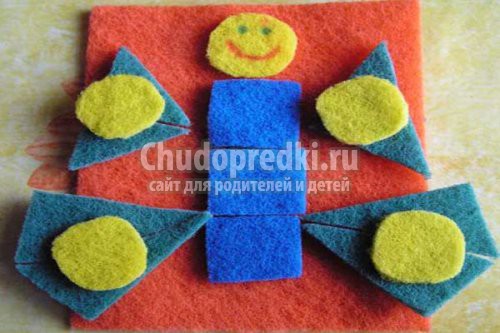
For this work we need:
Sheet felt in red, blue, blue and yellow;
Scissors;
PVA glue;
Colored markers.
Description of work.
1. Like all previous master classes, we will start this one by preparing the necessary details, on the basis of which our charming butterfly will be formed. To do this, cut out four identical small felt right-angled blue triangles and the same number of slightly larger triangles.
2. We cut the blue sheet felt into 3 approximately identical squares, and turn the yellow into five identical circles, each with a diameter of about 1.5 cm.
3. We will also take felt as the basis of the composition, in our case it is red. Cut out a large square. However, in this case, cardboard of a suitable shade can also be successfully used.
4. All components are prepared, you can proceed to collect the picture. We alternately glue each part onto the base, start with the body in the form of three squares, glue a yellow circle on top - the head. Please note, unlike paper, for gluing felt there is no need to lubricate the entire back surface of each detail with glue, it is enough to saturate the middle with it a little.
5. Following the torso and head, we form wings based on the made triangles and decorate each with a yellow circle.
6. In the end, we can only draw eyes and a smiling mouth on a butterfly with the help of colored felt-tip pens.
If you like our site, express your "thank you"
by clicking the buttons below.
1. Example
Target. To teach children to make geometric shapes from a certain number of sticks, using the technique of attaching to one figure, taken as a basis, to another.
Material: Children have counting sticks, a board, chalk on the tables in this and the next lesson.
Working process. 1. The teacher invites the children to count 5 sticks, check and put them in front of them. Then he says: “Tell me, how many sticks will it take to make a triangle, each side of which will be equal to one stick. How many sticks will it take to make two such triangles? You only have 5 sticks, but you also need to make 2 equal triangles from them. it can be done, and compose."
After most of the children complete the task, the teacher asks them to tell how to make 2 equal triangles of 5 sticks. Draws the attention of the children to the fact that the task can be done in different ways. Ways to do it should be sketched. When explaining, use the expression "attached to one triangle another from below" (on the left, etc.), and in explaining the solution of the problem, also use the expression "attached to one triangle another, using only 2 sticks."
2. Make 2 equal squares of 7 sticks (the teacher first specifies which geometric figure can be made up of 4 sticks). Gives the task: count 7 sticks and think about how to make 2 equal squares on the table.
After completing the task, consider different ways attachments to one square of another, the teacher draws them on the board.
Questions for analysis: “How did you make 2 equal squares out of 7 sticks? What did you do first, what then?
2. Example
Target. Compose figures by attaching. To see and show at the same time a new figure obtained as a result of drawing up; use the expression: "attached to one figure another", to consider practical actions.
Working process. The teacher invites the children to remember what figures they made using the attachment technique. Tells what they will do today - learn to make new, more complex figures. Gives tasks:
After completing the task, the teacher invites all children to make 3 triangles in a row so that a new figure is obtained - a quadrangle (Fig. 2). Children draw this solution with chalk on the blackboard. The teacher asks to show 3 separate triangles, a quadrilateral and a triangle (2 figures), a quadrilateral.
Rice. 2 Drawing shapes from triangles
2. From 9 sticks, make 4 equal triangles. Think about how this can be done, tell, then complete the task.
After that, the teacher invites the children to draw the drawn figures on the blackboard with chalk and talk about the sequence of the task.
Questions for analysis: "How did you make 4 equal triangles from 9 sticks? Which of the triangles did you make first? What figures did you get as a result and how many?"
The teacher, clarifying the answers of the children, says: "You can start making a figure from any triangle, and then attach others to it on the right or left, above or below."
3. Example
Target. Exercise children in independent searches for ways to draw up figures based on preliminary reflection on the course of the decision.
Working process. The teacher asks the children questions: "How many sticks can make a square, each side of which is equal to one stick? 2 squares? (out of 8 and 7). How will you make 2 squares out of 7 sticks?"
As the teacher completes, the teacher calls several children to draw the figures they have compiled on the board and tell the sequence of compilation. Invites all children to make a figure of 3 equal squares arranged in a row, horizontally. He draws the same one on the board and says: “Look at the board. Here it is drawn how you can solve this problem in different ways. You can attach another to one square, and then a third one. (Shows.) divide it into 3 equal squares with 2 chopsticks". (Shows.) Then he asks questions: "What shapes did you get and how many? How many rectangles did you get? Find and show them."
2. From 5 sticks, make a square and 2 equal triangles. Tell first, then compose.
When completing this task, children, as a rule, make a mistake: they make 2 triangles in a learned way - by adding, as a result of which a quadrangle is obtained. Therefore, the teacher draws the attention of the children to the condition of the problem, the need to draw up a square, suggests leading questions: “How many sticks do you need to make a square? Since you have sticks? Can you make it by attaching 1 triangle to another? How to make it? " After completing the task, the children explain how they did it: you need to make a square and divide it with 1 stick into 2 equal triangles.
4. Example
Target. Exercise children in the ability to express a hypothetical decision, to guess.
Working process. 1. From 9 sticks, make a square and 4 triangles. Think and say how to compose. (Several children make guesses.)
If the children find it difficult, the teacher advises: "Remember how you made a square and 2 triangles out of 5 sticks. Think and guess how you can complete the task. The one who solves the problem first will draw the resulting figure on the board."
After completing and sketching the answer, the teacher invites all children to make the same figures for themselves (Fig. 3).
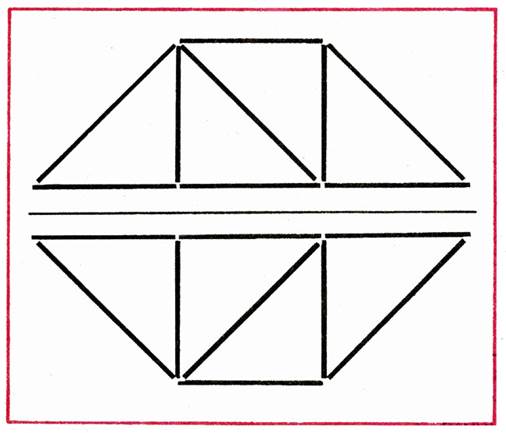
Rice. 3 Drawing shapes from triangles
Questions for analysis: "What geometric shapes did you get? How many triangles, squares, quadrangles? How did you compose? How is it more convenient, faster to compose?"
2. From 10 sticks, make 2 squares - small and large.
3. Make 5 triangles out of 9 sticks.
If necessary, in the course of completing the second and third tasks, the educator gives leading questions, advice: "First think, then make up. Do not repeat mistakes, look for a new solution. Does the problem say about the size of triangles? how to solve the problem".
So, in the initial period of teaching children 5 years to solve simple tasks on their ingenuity, they independently, mostly practically acting with chopsticks, are looking for a solution. In order to develop their ability to plan the course of thought, children should be invited to express preliminary reasoning or combine them with practical tests, explain the method and way of solving.
Several types of solutions to the problems of the first group are possible. Having mastered the method of attaching figures, subject to the commonality of the sides, children very easily and quickly give 2-3 solutions. Each figure at the same time differs from the previous spatial position. At the same time, children learn how to construct given figures by dividing the resulting geometric figure into several (a quadrangle or square into 2 triangles, a rectangle into 3 squares).
The solution with children aged 5-6 years of more complex tasks for rebuilding figures should begin with those in which, in order to change the figure, it is necessary to remove a certain number of sticks and the simplest - for shifting the sticks.
The process of children's search for solutions to problems of the second and third groups is much more complicated than that of the first group. To do this, you need to remember and comprehend the nature of the transformation and the result (what figures should be obtained and how much) and constantly, in the course of searching for a solution, correlate it with the proposed or already implemented changes. In the process of solving, a visual and mental analysis of the problem is necessary, the ability to imagine possible changes in the figure.
Thus, in the process of solving problems, children must master such mental operations of problem analysis, as a result of which they can mentally imagine various transformations, check them, then, discarding the wrong ones, look for and try new solutions. Education should be aimed at developing in children the ability to think over moves mentally, fully or partially solve the problem in the mind, and limit practical trials.
In what sequence should children of 5-6 years old be offered tasks for ingenuity of the second and third groups?
- In a figure consisting of 5 squares, remove 4 sticks, leaving one rectangle (Fig. 4).

Rice. 4
- In a figure consisting of 6 squares, remove 2 sticks so that 4 equal squares remain (Fig. 5).

Rice. five
- Make a house of 6 sticks, and then shift 2 sticks so that you get a flag (Fig. 6).
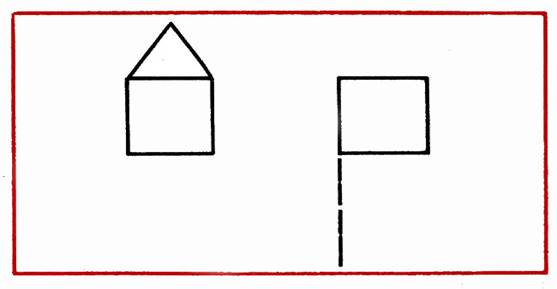
Rice. 6
- In this figure, shift 2 sticks to make 3 equal triangles (Fig. 7).
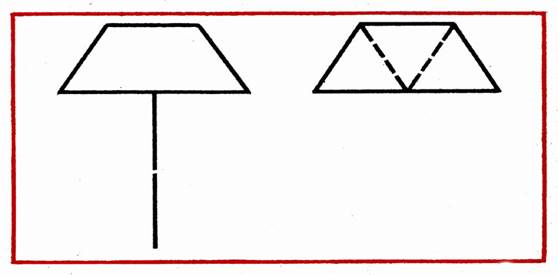
Rice. 7
- In a figure consisting of 5 squares, remove 3 sticks so that 3 of the same squares remain (Fig. 8).

Rice. 8
- In a figure consisting of 4 squares, remove 2 sticks so that 2 unequal squares remain (Fig. 9).
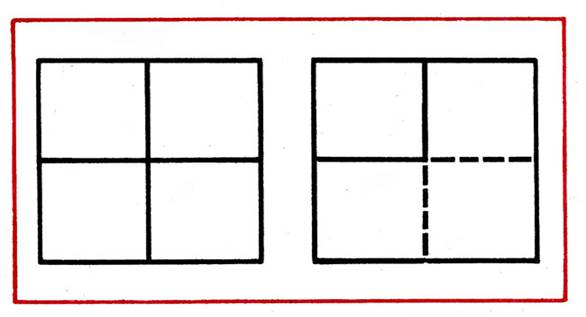
Rice. nine
- In a figure of 5 squares, remove 4 sticks so that 2 unequal squares remain (Fig. 10).
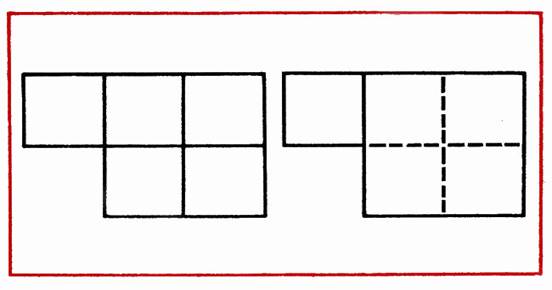
Rice. 10
- In the figure of 5 squares, remove 4 sticks so that 3 squares remain (Fig. 11).
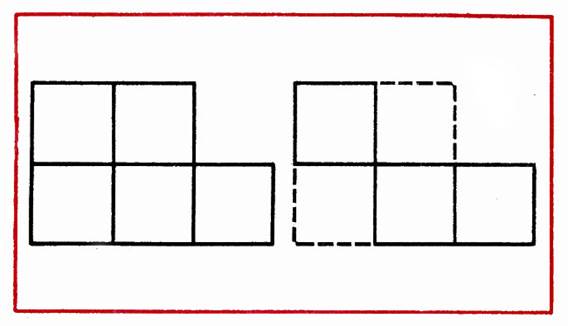
Rice. eleven
- In a figure of 4 squares, shift 2 sticks so that 5 squares are obtained (Fig. 12).

Rice. 12
- In the figure of 5 squares, remove 4 sticks so that 3 squares remain (Fig. 13).

Rice. 13
For these and other similar tasks, it is characteristic of ingenuity that the transformation necessary for solving leads to a change in the number of squares that make up a given figure (tasks 2, 5, etc.), a change in their size (tasks 6, 7), a modification shapes, such as converting squares to rectangles in problem 1.
In the course of classes, in order to guide the search activities of children, the educator uses various techniques that help to educate them in a positive attitude towards a long-term persistent search, but at the same time, the speed of reaction, the rejection of the developed search path. The interest of children is supported by the desire to achieve success, which requires active work of thought.
Valentina Shatokhina
The game "Tangram" as a means of developing ideas about geometric shapes
Destinations in development of geometric representations in preschool children are different. Familiarization with geometric shapes in terms of sensory culture, it differs from their study in the formation of initial mathematical representations. And, nevertheless, without sensory perception of the form, the transition to its logical awareness is impossible.
Form - property geometric figure, associated with the extent and with the property "to be in certain relationships in space"; so, the segment has the characteristic "length"(expressed numerically, but located on the plane in a certain way, gives quality new form - figure. And figure has the same properties as its constituent (limiting) segments, as well as new properties generated by this new quality, such as area or perimeter, also having numerical expressions. In its turn certain figures located in space in a certain way, give rise to new forms - bodies that have both all the previous properties (the length of the sides, the area of the faces, and a new property - the volume, which also has a numerical expression.
On the simplest illustrative examples geometric material allows you to acquaint children with the most important mathematical (and even philosophical) provisions, for example: before comparing items, it is necessary to establish by what property they should be compared; when changing position the subject's form(and hence the mass, area, length) does not change; the same subject from various positions (points of view) may look different, but it's still the same subject. Geometric figures at the same time, unlike abstract numerical characteristics, called numbers, they have sensually perceived visual properties and qualities, which allows them to be used in the process of mathematical development child almost from the first days of his life. While familiarizing preschoolers with geometric shapes develop following processes thinking Keywords: analysis, synthesis, comparison, generalization, classification.
Most effective method are didactic games. Special place among entertaining mathematical material is occupied by games for compiling planar images items, animals, birds, houses, ships from special sets geometric shapes. Sets figures are chosen not arbitrarily, but present part of the cut figure in a certain way: square, rectangle, circle or oval. These are the so-called puzzle games, designed to develop geometric representations and thinking of preschool children. They are interesting for children and adults. Children are fascinated by the result - to compose what they saw on the sample or what they intended. They are included in the active practical work on the selection of the method of location figures in order to create a silhouette.
A game« tangram» - one of simple games. They call her and "Puzzle Cardboard", « geometric constructor» and etc. A game easy to manufacture. A square 10X10 cm in size made of cardboard, plastic, equally colored on both sides, is cut into 7 parts. The result is 2 large, 1 middle and 2 small triangles, a square and a parallelogram. Using all 7 parts, tightly attaching them one to the other, you can make a lot various images according to samples and according to their own design. The essence of the game is to collect all kinds of figurines from these elements according to the mosaic principle. In total, there are more than 7,000 different combinations. The most common of them - animal and human figures.
The success of mastering the game at preschool age depends on the level of sensory child development. Children need to know more than just names geometric shapes, but also their properties, distinctive features, to master the methods of examining forms by visual and tactile-motor way, to freely move them in order to obtain a new figures. They must have developed the ability to analyze simple images, to distinguish in them and in others objects geometric shapes, practically modify figures by cutting and composing them from parts. This is one of the simple puzzles that a child can do from 3.5-4 years old.
A game« tangram» entered a series of puzzle games that were carried out with children of senior preschool age in order to development of geometric representations.
At the first stage of mastering the game « tangram» carried out a number of exercises aimed at development in children of spatial representations, elements geometric imagination, to develop practical skills in compiling new figures by attaching one of them to the other, aspect ratio shapes by size. Then the tasks were modified. The children made new figures according to the model, oral task, plan.
A more complex and interesting activity for children is the recreation figures according to contour samples (undivided)- the third stage of mastering the game, which is available to children 6-7 years old, subject to their training.
Recreation figures according to contour samples requires visual division of the form of one or another planar shapes into parts, i.e. on those geometric figures from which it is composed. It is possible under the condition of the correct arrangement of some components relative to others, compliance with their proportional ratio in size. Recreation is carried out during the selection (search) compilation method based on preliminary analysis and subsequent practical actions aimed at checking various ways mutual arrangement of parts. At this stage of training, one of the main tasks is to development children have the ability to analyze the shape of a planar figures according to its contour image, combinatorial abilities.
One of the first tasks at this stage is a running goose, we started work at this stage with this very sample. First, we analyzed together with the child what parts the head, neck, paws of a goose can consist of. They clarified whether they can be made of other parts. Farther offered children apply different puzzle pieces in order to find the correct result.
Next, we moved on to figures more difficult - laying out figurines man running and sitting. It's pretty difficult pieces in this puzzle, but as a result of systematic work, the children successfully completed this task. It should be noted that during the game « tangram» widely used poems, riddles, which contributed to the creation and maintenance of interest in gaming activities. In addition, we thought over a system of visual evaluation of children's activities - for the right decisions, quick uploading figurines, reasoning, explanation children received chips.
Behind figure building games-silhouettes according to the samples were followed by exercises in drawing up images according to their own design. We asked the children to remember how flat figures they learned to compose, and compose them. Each of the children made in turn 3-4 figures. These tasks also included an element of creativity. When submitting the form of some figures-silhouettes, the children reproduced the general outlines of the form, and the constituent elements of the individual parts were arranged somewhat differently than they had previously done according to the model. IN games self-development and compilation silhouette figures kids, thinking to compose any image, mentally, in terms of representation, divided it into its component parts, correlating them with the form tangrams, then composed. Children came up with and made interesting silhouette figures, with which you can supplement the supply of samples for the game « tangram» . At this stage of work suggested children to compose compositions from silhouette figures. Children composed compositions for the following themes: "Zoo", "Forest clearing", "On the river".
Children of the preparatory group with the aim development of creativity and more difficult tasks. From 2-3 identical sets figures for the game« tangram» compose silhouette figure, the plot both according to samples and according to their own design.
Thus, in the course of the work carried out, it was found that a game« tangram» promotes:
development in children of visual-figurative thinking, imagination, attention, understanding of color, size and shape, perception, combinatorial abilities, skills play according to the rules and follow the instructions; development a child with an analytical mindset; will help him learn how to make a model from given elements, break the whole object into parts, highlight in the image geometric figures.
A special place among mathematical entertainment is occupied by games for compiling planar images of objects, animals, birds, houses, ships from special sets of geometric shapes. In this case, the sets of figures are not selected arbitrarily, but are parts of a figure cut in a certain way: a square, rectangle, circle or oval. They are interesting for children and adults. Children are fascinated by the result - to compose what they saw on the sample or what they intended. They are included in the active practical work on the selection of the method of arranging the figures in order to create a silhouette.
Game "Tangram"
"Tangram" is one of the simple games. They also call it "Puzzle made of cardboard", "Geometric constructor", etc. The game is easy to manufacture. A square 8X8 cm in size made of cardboard, plastic, equally colored on both sides, is cut into 7 parts. The result is 2 large, 1 medium and 2 small triangles, a square and a parallelogram. Using all 7 parts, tightly attaching them one to another, you can make a lot of different images according to samples and according to your own design (Fig. 60).
The success of mastering the game at preschool age depends on the level of sensory development of children. Children should know not only the names of geometric shapes, but also their properties, distinguishing features, be able to examine forms visually and tactilely-motorly, freely move them in order to obtain a new figure. They must develop the ability to analyze simple images, to distinguish geometric shapes in them and in surrounding objects, to practically modify the figures by cutting and compose them from parts.
Successive stages of mastering the game "Tangram" in a group of children aged 5 years.
The first stage is getting acquainted with the set of figures for the game, transforming them in order to compile a new one from 2-3 available ones.
Examples (for children 6-7 years old)
Target. Exercise children in comparing triangles in size, composing new geometric shapes from them: squares, quadrangles, triangles.
Material: children have sets of figures for the game "Tangram", the teacher has a flannelograph and a set of figures for it.
Working process. The teacher invites the children to consider a set of figures, name them, count and determine the total number. Gives tasks:
Questions for analysis: "How many large, equal-sized triangles? How many small ones? Compare this (medium-sized) triangle with a large and small one. (It is larger than the smallest and smaller than the largest of the available ones.) How many triangles are there and what size are they?" (Two large, 2 small and 1 medium.)
2. Take 2 large triangles and make them sequentially: square, triangle, quadrilateral. One of the children makes figures on the flannelgraph. The teacher asks to name the newly received figure and say what figures it is made of.
3. From 2 small triangles, make the same figures, placing them differently in space.
4. Make a quadrilateral from large and medium-sized triangles.
Questions for analysis: "What figure will we make? How? (Let's attach the middle triangle to the large triangle or vice versa.) Show the sides and angles of the quadrangle, each individual figure."
As a result, the educator generalizes: "Triangles can be used to make new various shapes - squares, quadrangles, triangles. The figures are attached to one another on the sides." (Shows on flannelgraph.)
Target. Exercise children in the ability to compose new geometric shapes from existing ones according to the model and design.
Material: for children - sets of figures for the game "Tangram". The teacher has a flannelograph and tables with geometric figures depicted on them.
Working process. Children, having examined the figures, divide them on the instructions of the teacher into 2 groups: triangles and quadrangles.
The teacher explains that this is a set of figures for the game, it is called a puzzle or tangram; so she was named after the scientist; who invented the game. You can compose many interesting images.
Make a quadrilateral from the large and medium triangles.
Make a new shape from a square and 2 small triangles. (First - a square, then - a quadrangle.).
Make a new figure from 2 large and medium triangles. (Pentagon and quadrilateral.)
The teacher shows the tables and asks the children to make the same figures (Fig. 61). Children sequentially make figures, tell how they did it, name them.
The teacher composes them on a flannelograph.
The task is given to draw up several figures according to the children's own plan.
So, at the first stage of mastering the game "Tangram", a series of exercises are carried out aimed at developing children's spatial representations, elements of geometric imagination, at developing practical skills in composing new figures by attaching one of them to another, the ratio of the sides of the figures in size. Tasks are changing. Children make up new figures according to the model, oral task, plan. They are offered to complete the task in terms of presentation, and then - practically: "What figure can be made up of 2 triangles and 1 square? First say, and then compose." These exercises are preparatory to the second stage of mastering the game - drawing up silhouette figures according to dissected samples (A silhouette figure is a flat object image made up of parts of the game). The second stage of work with children is the most important for them to master more complex ways of drawing figures in the future.
Successful reconstruction of silhouette figures requires the ability to visually analyze the shape of a planar figure and its parts. In addition, when recreating a figure on a plane, it is very important to be able to mentally imagine changes in the arrangement of figures that occur as a result of their transfiguration. The simplest type of sample analysis is visual, but it is impossible without a developed ability to see the proportional ratio of the parts of the figure. The player is forced to look for a method of composing (arrangement of the components) of a silhouette figure from geometric figures, based on analysis data, in the process of testing various planned composition options.
Games for drawing silhouette figures according to dissected samples (the second stage of work) should be effectively used by the educator not only for the purpose of exercising in the arrangement of parts of the figure being composed, but also in introducing children to the visual and mental analysis of the sample. The children are shown a dissected sample (hare) and the goal is explained: to compose the same: Despite the apparent ease of "copying" the method of spatial arrangement of parts, children make mistakes in connecting the figures on the sides, in a proportional ratio. Errors are explained by the fact that independent analysis of the location of parts is not available to children of this age. They find it difficult to determine and name the relative magnitude of the constituent parts, dimensional ratios. So, instead of a large triangle, children can place a medium-sized triangle and notice an error only after the adult indicates. Thus, based on the characteristics of the analysis and practical actions of children, it is possible to determine the content of the work at the second stage of the deployment of games: this is the assimilation by children of the analysis plan of the presented sample, starting with the main parts, and the expression of the speech of the method of connection and spatial arrangement of parts.
The analysis is followed by exercises in drawing up, focusing on the image. The sample is not removed, children can refer to it again in case of difficulty. It should be made in the form of a table on a piece of paper and equal in size to the silhouette figure obtained as a result of compiling a set of figures for the game from the children's existing set. This facilitates the analysis and comparison (verification) of the reconstructed image with the sample in the first lessons. In the following lessons, as you gain experience in drawing figures, there is no need to adhere to this rule.
Examples (for children 6-7 years old)
Drawing a silhouette figure of a hare
Target. To teach children to analyze the way the parts are arranged, to compose, a silhouette figure, focusing on a sample.
Material: for children - a set of figures for the game "Tangram", a sample.
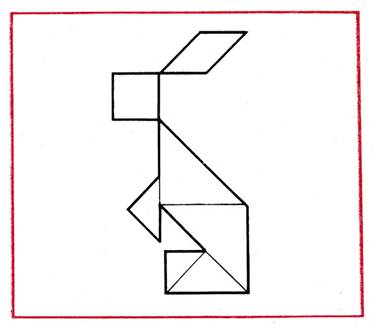
Working process. The teacher shows the children a sample figure-silhouette of a hare (Fig. 62) and says: "Look carefully at the hare and tell how it is made up. What geometric shapes make up the body, head, legs of the hare?" It is necessary to name the figure and its size, since the triangles that make up the hare (shows) are of different sizes; invites several children to answer.
Kolya. The head of the hare is made up of a square, the ear is made of a quadrangle, the body is made of two triangles, and the paws are also made of triangles.
Educator. Was Kolya correct? If you spot errors, correct them.
The teacher asks another child to tell.
Igor. The body must be made up of 2 large triangles, the paw (this one) - from the middle triangle and the small one, and the other - from the small triangle.
Educator. Now look at what geometric figure 2 large triangles form. Show the sides and angles of this figure.
Lena. This is a quadrilateral (shows its outline, counts angles, sides).
Educator. And what shape does the middle and small triangle form together?
Sasha. Rectangle.
Nadia. No, this is a quadrilateral, here (shows) not like a rectangle.
Educator. So we looked at how the hare is made up, from what figures the body, head, and paws are made up. Now take your kits and compose. Who will complete the task, check whether it is correct.
After the figure is composed, the teacher asks two children to tell how they made the figure, that is, to name the location of the components in order.
Sveta. I made it this way: the head and ear - from a square and a quadrangle, the body - from 2 large triangles, paws - from a medium and small one, and 1 paw - from a small triangle.
Ira. My ear is made up of a quadrangle, my head is made of a square, my paw is made of a triangle, my torso is made of large triangles, my paws - these are made of 2 triangles.
Sample analysis in this case was carried out under the guidance of a teacher. In the future, children should be invited to independently analyze the figure and draw it up. Children of 5 years old make up the simplest silhouette figures: a hare, a crane, a kangaroo, a fox, etc. (Fig. 63). During 5 lessons, using a dissected sample, children learn its clear analysis, the correct spatial arrangement of geometric shapes when recreating a planar image.

A more complex and interesting activity for children is the recreation of figures based on contour patterns (undivided) - the third stage of mastering the game, which is accessible to children of 6-7 years old, subject to their training.
Reconstruction of figures according to contour patterns requires visual division of the form of one or another planar figure into its constituent parts, i.e. into those geometric figures from which it is composed. It is possible under the condition of the correct arrangement of some components relative to others, compliance with their proportional ratio in size. Reconstruction is carried out in the course of choosing (search) for a method of composition based on a preliminary analysis and subsequent practical actions aimed at checking various ways of the relative position of the parts. At this stage of education, one of the main tasks is to develop in children the ability to analyze the shape of a planar figure according to its contour image, combinatorial abilities.
When moving from drawing up silhouette figures according to dissected samples to drawing up according to samples without specifying the constituent parts, it is important to show the children that it is difficult to make a figure on a plane without a preliminary careful examination of the sample. Children are offered to make 1-2 figures of silhouettes according to contour samples from among those that they had previously compiled according to dissected samples. The process of drawing up the figure in this case takes place on the basis of the formed representation and the visual analysis of the sample carried out at the beginning of the lesson. Such exercises provide a transition to the reconstruction of figures according to more complex patterns.
Considering that it is difficult for children to accurately indicate the location of the constituent parts in the analyzed undivided sample, it is necessary to offer them to conduct a presumptive analysis of the sample. At the same time, everyone analyzes the sample on their own, after which several options for the arrangement of parts are heard, the correctness or fallacy of which the educator does not confirm. This encourages practical verification of the results of a preliminary analysis of the arrangement of parts in the figure being composed, the search for new ways of spatial arrangement of constituent elements.
Recreation of the figure-silhouette of a running goose
Target. To teach children to presumably tell the way the parts are arranged in the figure being composed, to plan the course of compilation.
Material: sets, figures for the game "Tangram", flannelgraph, sample, board and chalk.
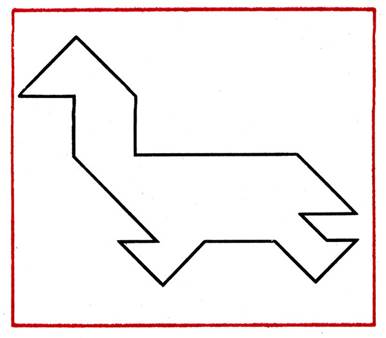
Working process. The teacher draws the attention of the children to the sample (Fig. 64): “Look carefully at this sample. The figure of a running goose can be made up of 7 parts of the game. You must first tell how this can be done. What geometric shapes can you make up the body, head, neck, goose legs?
Lena. I think that the body is made up of 2 large triangles, the head is made of a small triangle, the neck is made of a square, the paws are triangles.
Galya. I think that the head is made up from the middle triangle, and then everything is the same as Lena said.
Igor. The head is from a middle triangle, the neck is from a square, and the torso is from 2 large triangles, like this they lie (shows), and a quadrangle, and the legs are from small triangles.
Educator. Take the figures and compose. And we will find out which of the guys is right.
After most of the children make up the silhouette of a goose, the teacher calls one child who draws the location of the parts with chalk on the board. All children check the figures they have compiled with the image on the board.
In the course of work, the children make assumptions about the way the parts of the figure are placed, subjecting it to further practical verification. Helping them, the teacher emphasizes the need to follow a certain sequence in the analysis and the process of drawing up figures: from highlighting the main parts, made up of large figures, to highlighting other parts, made up of small figures.
In the future, it is possible to analyze a sample of the figure being compiled not at the beginning of the lesson, but during it, when the children test various ways of drawing up on the basis of a presumptive independent analysis, but the figure does not work out for them. This technique is especially justified when drawing up more complex figures, that is, those in the form of which it is difficult to determine the location of small parts (quadrilaterals, small triangles). These are planar images of a chicken, a Christmas tree, a fish, etc. In such cases, the analysis serves as a hint, which is most effective precisely in the process and at a certain stage of the task, when the problem solver has exhausted all possible methods, but his interest in the problem has not faded away. As independent exercises improve, the ability of children to perform a visual analysis of the sample, it becomes more and more accurate, specific. Search actions aimed at choosing an adequate method for the spatial arrangement of figures on the basis of a preliminary analysis become purposeful. Children begin to justify their actions and intentions.
Drawing up a figure-silhouette of a house
Target. To exercise children in the ability to carry out a hypothetical visual-mental analysis of the way the figures are arranged, checking it practically.
Materials: sets of figures for the game "Tangram". Sample, board and chalk.
Working process. Educator. Consider carefully the house - walls, roof, pipe (Fig. 65). Tell us how you would compose it from the existing set of shapes.

Kolya. The walls of the house must be folded from 2 large triangles (with a finger, as it were, making markings on the sample), - here they lie, it turns out a square. The pipe is a small square, now we will make up the roof. I still have a triangle, a quadrilateral, 1 more small triangle. I'll put it like this: the middle triangle, then the quadrilateral, it is necessary that the edges turn out ... (thinks).
Educator. What do you think the roof is made up of?
Kolya. From the middle and 2 small triangles and even a quadrangle.
Radik. The walls are made of 2 large triangles, the pipe is made of 2 small ones, and the roof is made up of other figures. I’ll make it up now, if it doesn’t work out, then it’s necessary in a different way, but it seems to me that it is.
After completing, the children depict graphically, in chalk on the board, the way the figures are arranged in the silhouette of the house. It is noted that many of the children, even before compiling, visually correctly distributed the figures.
Over the course of a number of lessons, the children make up several more silhouette figures based on undivided samples (Fig. 66).
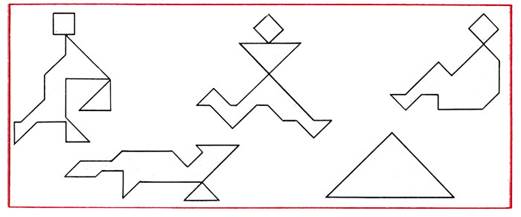
The games of composing figures-silhouettes according to the samples are followed by exercises in composing images according to one's own plan. In the lesson, children are asked to remember what flat figures they learned to compose, and compose them. Each of the children makes 3-4 figures in turn. These classes also include an element of creativity. When transferring the form of some silhouette figures, children reproduce the general outlines of the form, and the constituent elements of individual parts are arranged somewhat differently than they did previously according to the model.
In games of independently inventing and composing silhouette figures, children, having decided to compose an image, mentally, in terms of representation, divide it into its component parts, correlating them with the shape of tangrams., Then compose. Children come up with and make up interesting silhouette figures that can be used to supplement the stock of samples for the game "Tangram" (For more details, see: Preschool Education, 1971, No. 1).
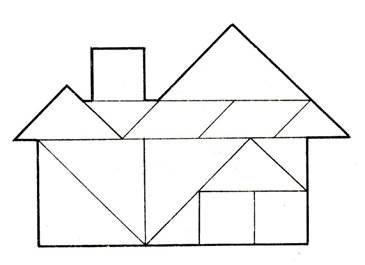
children preparatory group In order to develop creativity, more complex tasks can be offered. From 2-3 identical sets of figures for the game "Tangram" make a figure-silhouette, a plot both according to the samples and according to your own plan (Fig. 67). The figure shows a sample (house) with an indication of the components.
Make a figure out of 2 sets
It is quite difficult to recreate a silhouette figure or plot based on the model from 2 sets for the game "Tangram", since you have to operate with a large number of parts (up to 14).
The use of samples with the location of the parts in the figure-silhouette indicated by numbers makes the task easier, although in this case the lightness is only apparent.
We conditionally number (remember the numbers) the figures as follows: small triangles - 1, squares - 2, quadrangles - 3, medium-sized triangles - 4, large triangles - 5.
Drawing up a silhouette figure according to a model with a digital designation of the location requires active mental activity. Only the location of the figures is indicated, for example, small triangles with the number 1, and not the way they are located (direction, combination with other figures). A child who makes up a silhouette figure must constantly focus on the shape of the figure or its individual parts. So, in the course of drawing up the silhouette of a man on a horse, shown in Figure 68, after the relative determination of the location of geometric shapes, their more careful distribution follows. It is required to arrange each of the figures in space in such a way that the direction of the lines, the ratio of parts in size, shape creates an image. Therefore, in the process of searching for an adequate way of arranging the figures, the solver of the problem is forced to constantly present the shape of the figure being composed as a whole and divided into parts.
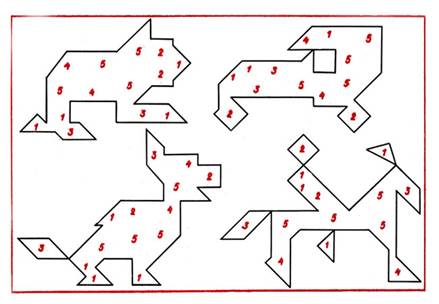
The management of the compilation process should be aimed at developing the ability to anticipate the combination of figures, changes in their location and the shape of the silhouette being composed.
So, in teaching children 5-6 years old to recreate silhouette figures from parts of the Tangram game, the sequence of task complication can be represented in the following way: from mastering the elementary methods of visual analysis, children move on to mastering the methods of mental actions.
The complication of tasks and the change in the nature of the management of the process of reconstruction by the teacher, the increase in the role of independent actions of children in the course of the search for composition help them master more advanced methods of transfiguration, on the basis of which it is possible to model object images according to their own design.
Puzzle game "Pythagoras"
(Puzzle "Pythagoras" is produced by the industry with a set of samples attached to it)
In working with children 6-7 years old, the game is used to develop mental activity, spatial representation, imagination, ingenuity and quick wits.
Description of the game. A 7X7 cm square is cut in such a way that 7 geometric shapes are obtained: 2 squares of different sizes, 2 small triangles, 2 large ones (in comparison with small ones) and 1 quadrilateral (parallelogram). Children call this quadrilateral figure (Fig. 69).

The goal of the game is to compose of 7 geometric shapes - parts of the game, flat images: silhouettes of buildings, objects, animals.
The set for the game is represented by figures. Therefore, the game can be used by the teacher in teaching children in the classroom in order to consolidate ideas about geometric shapes, ways to modify them by compiling new geometric shapes from 2-3 available ones.
Introducing children to the game "Pythagoras" begins with familiarization with the set of figures that will be required for the game. It is necessary to consider all geometric shapes, count, name them, compare in size, group, selecting all triangles, quadrangles. After that, invite the children to make new ones from the set of figures. From 2 large, and then small triangles, make a square, triangle, quadrilateral. In this case, the newly obtained figures are equal in size to those in the set. So, from 2 large triangles, a quadrilateral of the same size is obtained, a square equal in size to a large square. It is necessary to help children notice this similarity of figures, compare them in size not only by eye, but also by superimposing one figure on another. After that, you can make more complex geometric shapes - from 3, 4 parts. For example, make a rectangle from 2 small triangles and a small square; from a parallelogram, 2 large triangles and a large square - a rectangle.
Taking into account the experience gained by children in the process of mastering the game "Tangram", the teacher, in the course of teaching a new game, uses a number of methodological techniques that contribute to the manifestation of children's interest in it, helping children quickly master new game while showing creativity and initiative.
At the lesson, the teacher offers the children samples to choose from - dissected and contour. Each of the children can choose a pattern of their choice and make a figure. The teacher points out that it is more difficult and interesting to make a silhouette figure according to a model without specifying the components. In this case, you must independently find a way to arrange the parts (Fig. 70).
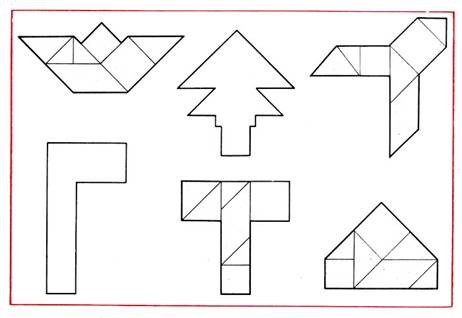
In the process of guiding children's activities in drawing up silhouette figures, the teacher uses a variety of methods to help maintain children's interest, stimulating active mental activity.
1. In case of difficulty in drawing up a silhouette figure according to an undivided sample, offer the child a sample indicating the location of the 1st and 2nd parts of the game from the given 7 parts. The rest the child arranges independently. So, in the silhouette of the fungus, the location of one of the large triangles is indicated. In the house - a large square and a triangle (Fig. 71). In this case, the solution to the problem of drawing up a figure is partially suggested to the child by adults. This affects the effectiveness of drawing up figures, the process of finding a way to arrange them becomes shorter and more successful. Children can overlay parts of the game directly onto the pattern.
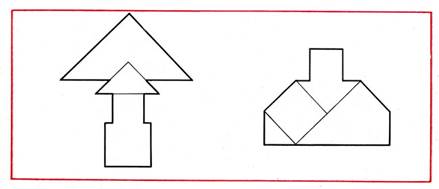
2. An adult, observing the process of drawing up a figure by a child, confirms the correct location of the individual parts of the game.
For example, in the course of drawing up a figure-silhouette of a triangle, depending on the progress of the search for the spatial arrangement of parts, the educator indicates the correct determination of the place for triangles or squares (Fig. 72). In this case, the child operates with a smaller number of figures, independently arranging them. It also affects the success of the task. 3. Analyzing the sample, the teacher invites the child to consider it, think about how the parts of the game are located in it. Allow him to draw on paper the method of arranging the parts or make markings directly on the sample, on the board with chalk. The use of graphics techniques practical ways finding ways to arrange the figures makes the analysis more accurate. Children quickly guess about the method of arrangement, give their own options for composing a silhouette figure.
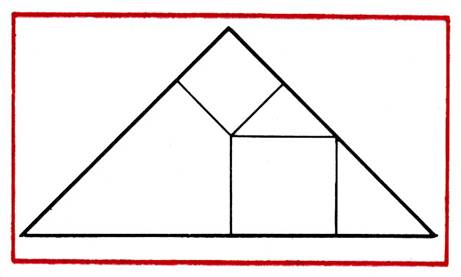
4. After examining the sample, i.e., its visual-mental analysis, the teacher asks the child to tell about the method of arranging the figures. At the same time, he emphasizes that he practically checks his guess, each time discarding the wrong solutions. Such an analysis is possible under the condition of a developed analyzing perception, flexibility and mobility of thought, constant orientation to the image of the composed silhouette figure. The persistent search for new ways of combining figures leads the child to a positive result.
5. A positive assessment of the activity of searching for a way to arrange the figures, carried out by children practically, mentally or in a combination of mental and practical actions is important: to encourage, approve the manifestation of ingenuity, perseverance, initiative, the desire to invent and compose a completely new figure or partially modify the sample.
6. As children master the methods of composing silhouette figures, it is appropriate to offer them tasks of a creative nature, to stimulate manifestations of ingenuity and resourcefulness. The silhouette figures newly invented and composed by the children are sketched into an individual album.
In the course of training in the classroom, children of senior preschool age (5-7 years old) quickly master games to recreate figurative, plot images from special sets of figures, which become for them one of the means of filling their leisure time.
Riddles, joke tasks, entertaining questions in teaching children in the classroom
From diversity math games and entertainment for children at preschool age are available, riddles and joke tasks are interesting.
In riddles of mathematical content, the subject is analyzed from a quantitative, spatial, temporal point of view, the simplest mathematical relations are noticed:
Two ends, two rings, and a carnation in the middle. (Scissors.) Four brothers live under one roof. (Table.) Five brothers live in one house. (Mitten.) Antoshka stands on one leg. Where the sun is, there he will look. (Sunflower.) There are no legs, but I walk, there is no mouth, but I will say: when to sleep, when to get up. (Watch.) The grandfather is sitting in a hundred fur coats, whoever undresses him sheds tears. (Luke.) One hundred brothers live in a red house, they all look alike. (Watermelon.) We are 7 brothers, all equal in years, but different in name. Guess who we are. (Days of the week.) In a year, grandfather has 4 names. Who is it? (Spring, summer, autumn, winter.) 12 brothers walk one after another, do not find each other. (Months.) Who changes clothes 4 times a year? (Earth.) Many arms, but one leg. (Tree.) Five boys, five closets, the boys dispersed into dark closets. (Fingers in a glove.) In order not to freeze, 5 guys are sitting in a knitted stove. (Mitten.) Four legs, but can't walk. (Table.)
Joke problems are entertaining game problems with mathematical meaning. To solve them, it is necessary to show resourcefulness, ingenuity, understanding of humor to a greater extent, rather than knowledge in mathematics. The structure, content, question in these problems are unusual. They only indirectly resemble a mathematical problem. The essence of the task, i.e. the main one, thanks to which you can guess the solution, give an answer, is masked by external conditions, secondary (below are joke tasks for children 6-7 years old).
You, me, and you and me. How many of us are there? (Two.)
How to form a triangle on the table with only one stick? (Put it on the corner of the table.)
How many ends does a stick have? Two sticks? Two and a half? (6.)
There are 3 sticks in a row on the table. How to make the middle extreme without touching it? (Shift the last one.)
How to form a square on the table with 2 sticks? (Place them in the corner of the table.)
Three horses ran 5 km. How many kilometers did each horse run? (For 5 km.)
If a chicken stands on one leg, then it weighs 2 kg. How much will a chicken weigh if it stands on 2 legs? (2 kg.)
Three brothers have one sister. How many children are in the family? (Four.)
It is necessary to divide 5 apples among 5 girls so that one apple remains in the basket. (One should take the apple along with the basket.)
4 birches grew. Each birch has 4 large branches. Each large branch has 4 small ones. On each small branch - 4 apples. How many apples are there? (None. Apples don't grow on birch trees.)
Can it rain 2 days in a row? (It can't. The night separates the days.)
There were 4 apples on the table, one of them was cut in half. How many apples are on the table? (4.)
One man was asked how many children he had. The answer was this; "I have 6 sons, and each has a sister." (7.)
Which figure has neither a beginning nor an end? (At the ring.)
How can you pluck a branch without frightening the birds on it? (Impossible, fly away.)
The purpose of riddles and tasks-jokes, entertaining questions is to introduce children to active mental activity, to develop the ability to highlight the main, essential properties, mathematical relationships, masked by external non-essential data. They can be used by the educator in the process of conversations, conversations, observations with children of any phenomena, that is, in the case when the situation necessary for this is created.
The study of the features of perception and understanding by children of senior preschool age (5-7 years old) of joke tasks showed that the success of solving them depends on how much children understand the joke, i.e., whether they are able to distinguish it in literary works, invent. Otherwise, children, as a rule, approach solving joke problems from the position of arithmetic, and begin to perform actions with numbers. The result of solving joke problems by children depends on their life experience, development of ideas about surrounding objects and phenomena, the ability to see, observe and notice the unusual in the ordinary. The creation of a situation, an environment similar to that referred to in the task, a practical test, a sketch and proof of the correctness of a guess, conjecture, an indication of the need to think, guess, solving similar problems will help the child understand the meaning of the joke task.
In the classroom for the formation of children 6-7 years of elementary mathematical representations joke tasks can be offered to children at the very beginning of the lesson as a small mental gymnastics. Their purpose in this case is to create a positive emotional state among the children, interest in the upcoming activities in the classroom, activity. The teacher offers 1, 2 simple entertaining tasks that are solved by children quickly, with little or no justification.
Entertaining questions, tasks, riddles are used by the educator and during the lesson in mathematics in order to clarify, concretize the knowledge of children about numbers, their purpose, geometric shapes, temporal relationships. At the same time, entertaining material is selected based on the purpose, occupation and level of development of children.
In the process of teaching children to solve arithmetic problems, the method of comparing a joke problem, a riddle of mathematical content, with an arithmetic problem is used. During the analysis of tasks, finding similarities and differences between them, the children's understanding of the structure of an arithmetic problem, the assignment of numbers, the need to perform arithmetic operations with numbers are clarified. Joking tasks are selected by the teacher according to the purpose and content of the upcoming lesson, depending on the purpose of the comparison technique, the level of formation of ideas about arithmetic tasks in children, and their development logical thinking.
During the lesson, especially when moving from one part of the lesson to another, changing activities, entertaining tasks can serve as a means of activating, switching the attention of children, and intellectual rest.
So, methodically correctly selected and appropriately used entertaining material (riddles, joke problems, entertaining questions) contribute to the development of logical thinking, observation, resourcefulness, quick reaction, interest in mastering "mathematical knowledge and dependencies, the formation of search approaches to solving any problem.
